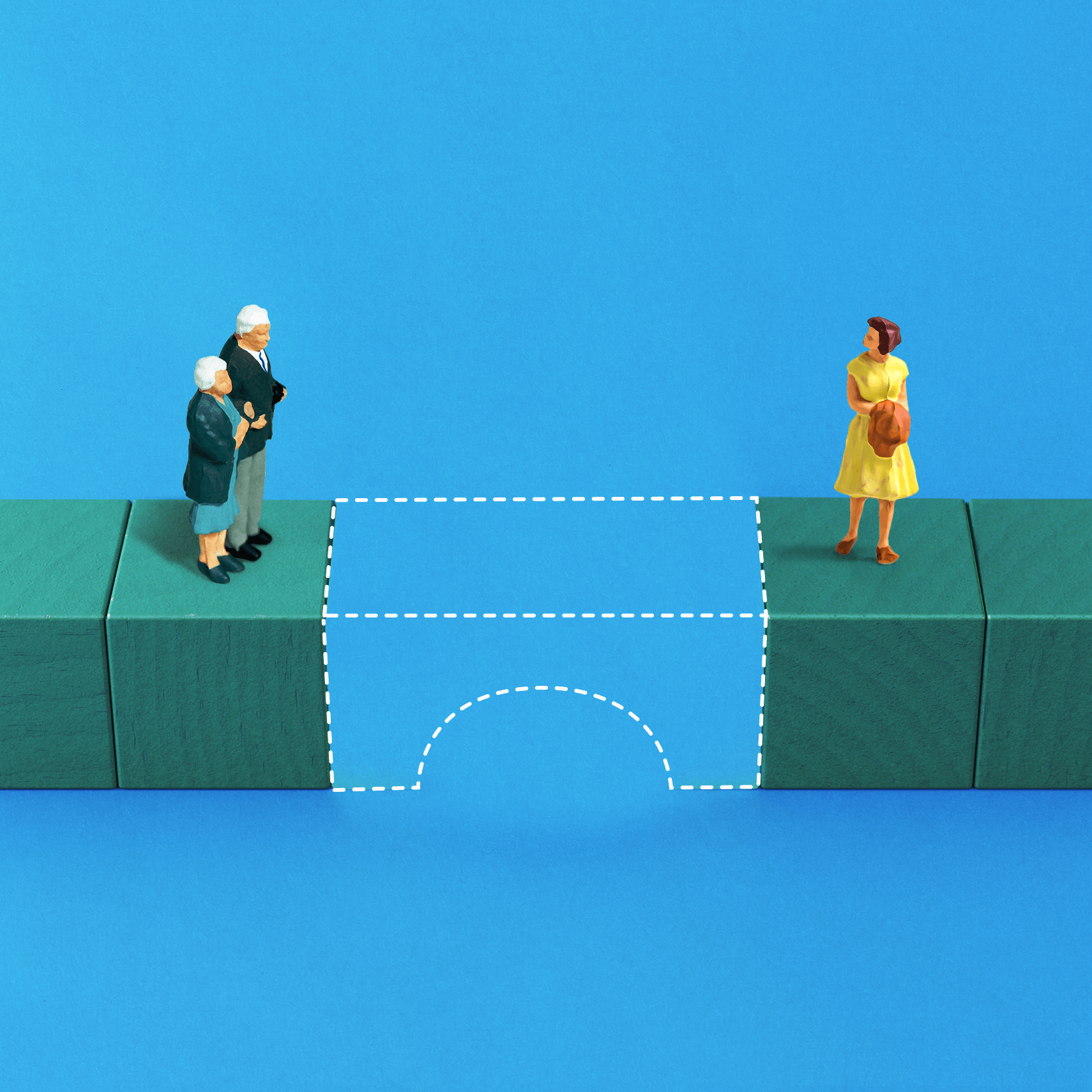When Adult Children Go ‘No Contact’
Can fractured families be patched back together? Should they be?
By Jan Tuckwood
Photo illustrations by Paul Spella

SALLY CONNELLY* describes herself as “a caring mother of five to whom the unthinkable happened.”
Two weeks before her son’s wedding, she says she received a midnight call from him, informing her that he, his fiancée and her family would not be attending the rehearsal dinner she had planned to host. As she remembers, his tone was so cold. She and her husband were in disbelief.
“A few days later, he phoned to confirm that we wouldn’t be at the wedding, calling us, his own family, ‘your side.’ It was all so strange and hard to accept that he could be so cold,” Connelly recalls. “We were devastated.”
That moment was the end of a relationship Connelly had hoped to nurture throughout her life.
For a mother who says she dedicated her whole life to her kids, the reality is harsh: Connelly has now lived nearly one-quarter of her life—15 of her 64 years—without that son.
She still isn’t sure why. Her son could not be reached for comment.
“Estrangement can take many paths,” says psychologist Joshua Coleman, author of Rules of Estrangement: Why Adult Children Cut Ties and How to Heal the Conflict. “Sometimes parents do very little to cause an estrangement. And sometimes they do a lot.”
Some parents or their adult children are mentally ill or have addictions. Some have partners who alienate them from their families. Politics and values are also factors, as is divorce. And some parents really are abusive or neglectful.
Coleman knows the subject firsthand. His own daughter cut him off for a period in her 20s, when she was coming to terms with her parents’ divorce. Coleman is now close with his daughter, but the years when she barely talked to him “were the most painful and confusing years of my life.”
A 2020 national survey by a Cornell University sociologist revealed that 27 percent of Americans reported being estranged from at least one family member. A 2023 study published in the Journal of Marriage and Family found that 6 percent of respondents were estranged from their mothers and that 26 percent were estranged from their fathers.
“People are finally realizing that biology alone does not guarantee safe, supportive relationships,” says Sherrie Campbell, a psychologist and author of Adult Survivors of Toxic Family Members.
Every human is flawed, of course, and every family dynamic is different.
Connelly’s midnight call from her son was unusual. In most cases, adult children try for years to have their emotional needs recognized by their parents before they become estranged, says Becca Bland, 38, a British therapist and researcher who started the nonprofit organization Stand Alone to support estranged adults. Bland’s relationship with her mother fell apart 14 years ago, and efforts to resolve conflicts failed.
Well-meaning people who did not understand the lasting damage a toxic relationship with parents can inflict could not understand Bland’s decision. “But it’s your mother,” they would say.
“No one is entitled to anything in the adult relationship. It’s all earned by respect,” Bland says. She encourages both parties to say: “I’ve got boundaries. This is how you show me respect. This is how you love me.”
If this sounds like “therapy speak,” listen up. It’s getting louder.
The expectations have changed from an era when children were expected to endure even abusive behavior from a parent. Some of those children of the 1950s, ’60s and ’70s learned behavior patterns from their parents. But they now have children who aren’t inclined to accept or forgive it.

Mary, 41, went “no contact” with her mother five years ago, but she says she still hears her mother’s critical voice in her head: “You’re not good enough. You’re not pretty enough. You’re not thin enough.” Mary, which is not her real name, spent years in therapy. She believes her mother is a narcissist who lashed out at her own children to protect her own childhood wounds, fear and shame.
Social media boards are filled with posts from “ACONs”—adult children of narcissists. Estranged parents have plenty of sounding boards too.
“I won’t love someone who hates me,” one mother wrote on gransnet.com, a site for grandparents.
Coleman notes that “there’s been a moral shift in the past half-century away from the ideals of ‘honor thy mother and thy father’ and ‘respect the elders’—however problematic those were—and more toward family life being oriented around whether or not relationships feel mutually respectful.” Parents in the ’50s expected their kids to mow the lawn, not mull the state of their mental health.
Now there’s TikTok and a “toxic parents” Reddit board, as well as support groups on social media.
Societal institutions are not as strong today, Coleman says, while individualism is rising. Social media boosts the idea that we deserve relationships that serve our personal growth.
For her part, Connelly has learned to live with the uncertainty of why her son cut her off.
Even so, “estrangement is not natural. It’s chaotic, and sometimes children accuse parents of outright lies and display puzzling behavior that causes the parent to worry about the child,” Connelly says. Her story has no fairy-tale ending.
“After 15 years, we are strangers,” Connelly says of her son.
Coleman knows he is fortunate to have recovered his relationship with his daughter. He says reconciliation is so hard because it often requires parents to drop the defensiveness and see themselves as their child sees them.
“Parents have to go first,” he says. “They have to give their child the space and time to talk about why the estrangement was necessary.”
He suggests writing a letter, starting with “I know you wouldn’t have done this unless you thought it was the healthiest thing for you to do.”
Getting the child back in conversation is “an act of humility, not humiliation,” he says. It is the first step in moving forward.
* Connelly is a pseudonym.
Jan Tuckwood is an award-winning journalist who was an editor at The Palm Beach Post and The Denver Post. Her work has appeared in many publications.
Getty Images, 3; Shutterstock, 2; Getty Images